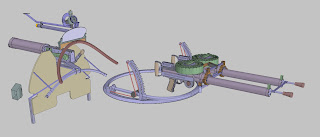I have decided to built a RE8 to fabric covering stage in my own workshop, hopefully beginning in April. It will be as externally accurate as possible. The RE8 was operated by No.3 Squadron, Australian Flying Corps in the Great War.
General Arrangement - Front:
General Arrangement - Rear:
Fuselage:
Fuselage structure and the engine and propeller mount forward of the 'firewall'. Mostly aluminium construction.
Propeller:
Fabricating the 4 blade will present considerable challenges.
Prop Installation:
Propeller installed in the engine/propeller mount.
Engine Installation:
The engine is fabricated from laminated ply, 3D printed parts and aluminium baffles / cooling duct. The exhaust ejects over the top centre section.
Top Centre Section:
Bottom Centre Section:
Wings:
External Cabling:
There is considerable external cabling including flying and landing wires, top wing extension support and aileron cables.
Struts:
Wing, cabane and aileron interconnection.
Empennage:
Stern Post:
Rudder:
Fins - Top and Bottom:
Horizontal Stabiliser:
Elevator:
External Bracing:
Top Deck:
The top deck includes the fuel tank, instrument panel, Scarff ring mount and turtle deck. The fairing around the pilot/observer cockpits to be designed.
Fuel Tank:
The fuel tank forms part of the external surface. The bracket to the front supports the header tank filler cap and vent.
Instrument Panel:
A very basic panel includes altitude gauge, RPM gauge, oil pressure, compass and compass card, inclinometer, clock and electrical switches. Under the windscreen is a 'reflector' fuel gauge.
Scarff Ring Mount:
Turtle Deck:
Cooper Bombs:
Under each wing.
Sighting:
Ring and bead sight on the left and Aldis sight (tube) on the right.
Vickers Gun:
Gun cocking is accessible by the pilot.
Undercarriage:
Main Wheels:
Tail Skid:


















































